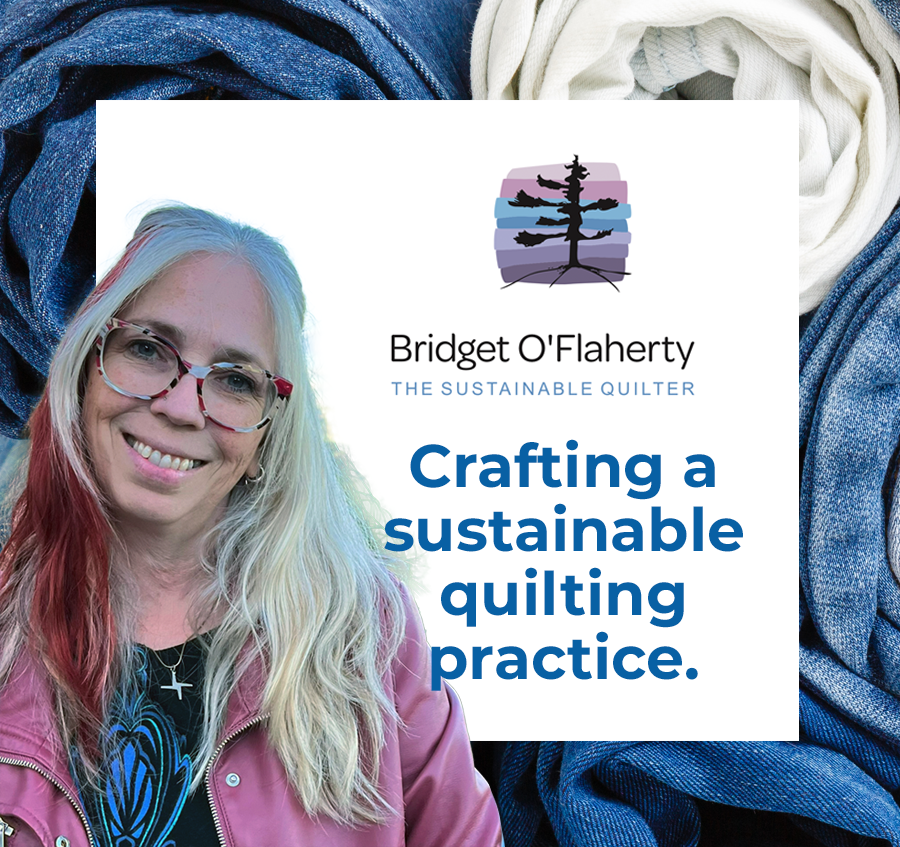TAKING STOCK
Crafting a Sustainable Quilting Practice
I’ve been watching with delight over the last year or two. The textile world, and the quilting world along with it, is changing. Sustainability is not just a concept that no one understands in this industry anymore.
In the last two years, major quilt shows have not only accommodated sustainability or upcycling in their prize-winning categories, but they have also awarded show prizes to quilts with secondary sustainable meanings, like advocating for human and animal rights or environmental and social issues, alongside their prowess in execution. Sue Sherman and Bill Stearman are some great Canadian examples.
Wholesale distributors have introduced organic products (Cloud 9, Organic Cotton plus, and Birch fabrics as well as Scanfil Organic, Gütermann and Mettler rPet and Madeira lyocell threads for example) for the general market—it is no longer niche to access organic materials and threads. Some manufacturers are now using recycled materials for production and earth-friendly materials for packaging as a matter of course.
The more we see this in the mainstream, the more normalized and cost-competitive it will become. It’s an exciting time, but there is still a long way to go. The vast majority of textile production is still status quo from early industrialized practices, but as ever, I want to focus on the good that is being done and offer solutions for those who may want to make changes.
Over the last two years of writing articles for CQA/ACC and guest speaking at guilds, I have received many messages from folks like you, those who are learning the ropes around sustainable practices, and those who want to share how they are making strides. You’ve shared gorgeous, finished projects that have upcycled materials or environmental themes, quilts you’ve made for local causes, and you’ve told me about the strides your guilds are making around highlighting and embracing sustainable practices. Projects like fabric or block swaps, guild annual challenges, donation quilts, and even categories being added at guild shows that recognize the importance of sustainability in quilting. You’ve also talked about how approaching quilting and textiles with mindfulness has changed how you feel daily. I still get questions often about how to approach sustainability when you’ve been quilting for years, how to get started.
This article will focus on how you might approach your textile practice this year to expand on sustainable practices and give you some examples of folks doing this work in the industry. Changing habits takes practice, and setting goals helps. We need to start with where we are and find a realistic path forward. Let’s take a look at a possible path.
DEFINING SUSTAINABLE GOALS
Setting Sustainability Goals
Setting sustainability goals for your quilting practice allows you to make mindful, intentional choices that align with your values and helps reduce the environmental impact of textile production. It’s not about achieving perfection, but rather about taking small, manageable steps that contribute to a more sustainable future—whether by reducing waste, supporting ethical brands, or rethinking purchasing habits. By setting clear, realistic goals, you can integrate sustainability into every aspect of your quilting, making a positive difference in both your creative practice and the world around you.
Short-Term Goals
- Commit to using your stash for the next three projects before purchasing anything new.
- Explore sustainable fabric brands or try sourcing fabric from second-hand shops.
- Join or start a fabric exchange group.
- Commit to completing at least one UFO this year.
Long-Term Goals
- Commit to a no-purchase practice.
- Transition to using organic, ethically sourced materials.
- Embrace zero-waste quilting methods, like incorporating all scraps into new projects.
- Consider switching to energy-efficient lights, smart thermostats, and/or green power for your sewing space.
BUILDING A PLAN OF ACTION
Assessing Your Current Practice
The first step in creating a sustainable quilting practice is taking stock of what you already have and what your current habits are. This is an opportunity to inventory your fabric, tools, patterns, and unfinished projects, and assess how you approach your purchasing, waste, and project management. By evaluating these, you’ll better understand what no longer serves you and can clear space for creative flow.
Analyzing Your Habits and Your Stash
- Purchasing Patterns: Are you buying fabric for specific projects or accumulating material without a clear plan? Take stock of how often you use what you already own. Are you influenced by trends, sales, or genuine need?
- Evaluating Waste: How much waste do you generate? From fabric scraps to packaging, how can you minimize this impact? Consider ways to repurpose, recycle, or donate excess materials.
- Consider your UFOs (unfinished objects). How many projects have you started and not finished? UFOs can be a significant source of fabric waste and mental clutter. Completing even just one or two of these projects can help you use materials you already have, reduce waste, and give you a sense of accomplishment.
Mindful Quilting Practices
Beyond what you buy, think about how you approach quilting as a whole. Consider incorporating practices that help minimize waste and make the most of your resources. Here are a couple of ideas:
- Scrap Projects: Instead of tossing fabric scraps, challenge yourself to create something beautiful from them. Scrap quilts, fabric baskets, or even small art pieces can breathe new life into what might otherwise be discarded.
- Repair and Reuse: If a quilt gets damaged, don’t give up on it. Learn how to patch and repair it, or repurpose it into something new.
Taking stock also means making room by passing along materials or tools you no longer need. This practice supports circular economies and can feel incredibly rewarding. However, it can also feel overwhelming. To make it easier, I recommend breaking it down into small, manageable steps, allowing yourself time to go through your stash thoughtfully. Reflect on each fabric or tool carefully. Here’s a suggestion.
The Three-Pile System
- Love it, need it—keep: Items you use often, have plans for, and love.
- Occasionally used—maybe keep: Items you might use but aren’t essential.
- Rarely used—time to go: Items you haven’t used in years and probably never will.
If you have the bandwidth, looking at pile two again with the same three categories in mind will help you further distill your stash.
The third pile is your giveaway/sell pile. Find somewhere meaningful for it to go. You can utilize reuse marketplaces, or you can donate to a cause. Many guilds have free tables or sale tables. It’s a great way to make sure it gets into the hands of someone who will use it rather than the landfill.
The key to making sustainable changes is to start small, focus on what feels manageable, and prioritize what is meaningful to you. Set goals that align with your values and capabilities. Change doesn’t happen overnight, but incremental steps build momentum.
Reflect and Celebrate
- Journaling: Keep a journal to reflect on your progress, your thoughts on sustainability, and what inspires you along the way.
- Celebrate Small Wins: Whether it’s completing a quilt entirely from your stash or donating unused fabric, take time to celebrate. These small victories can encourage further progress.
- Community Connection: Engage with like-minded quilters through guilds, online groups, or casual swaps. You can draw inspiration from each other, and the community support will keep you motivated.
Canadian Quilters Championing Sustainability
Across Canada, many quilters and organizations are making meaningful strides in sustainable quilting. Here are a few shining examples:
Toronto Modern Quilt Guild: This guild has been known for promoting sustainability through fabric swaps, workshops on repurposing materials, and embracing eco-friendly techniques. They also encourage members to explore upcycling in their quilt designs.
Ottawa Valley Quilters’ Guild: This guild focuses on sustainability through various initiatives, such as organizing fabric swaps and holding workshops that emphasize using upcycled fabrics and reducing textile waste.
Vancouver Modern Quilt Guild: Members of this guild are encouraged to incorporate sustainable practices, with an emphasis on upcycling fabrics and using organic or eco-friendly materials in their projects.
Calgary Modern Quilt Guild: Known for their commitment to sustainability, they promote responsible fabric purchasing, waste reduction, and community outreach programs that include quilting for charitable causes.
Beaconsfield Quilt Guild: Based in Quebec, this guild is actively involved in promoting sustainable quilting practices, including organizing fabric swaps and encouraging the use of repurposed materials in quilting projects.
Suggestions for Sustainable Quilting
As you work toward building sustainable habits, here are some resources to help you on your journey:
- Fabric and Notion Sources: Look for Canadian companies offering sustainable fabrics and ethically sourced products. Certifications like GOTS or OEKO-TEX can help guide your choices.
- Reuse Centres: Find local or online stores that offer new-to-you materials. See earlier articles for resources (they are posted on the CQA/ACC Blog).
- Waste Reduction Tips: Repurpose scraps into small projects or recycle them into stuffing. Minimize packaging waste by shopping locally or choosing stores with eco-friendly practices.
- Support Networks: Get involved with organizations like Grandmothers to Grandmothers, Victoria Quilts, or Quilts for Survivors, which accept donations to support meaningful causes.
As we set goals, take stock, and begin making mindful changes, we are not just shaping our own quilting practices, but also contributing to a broader movement toward sustainability in the textile world. Every fabric choice, every decision to repurpose or share materials, and every shift in how we engage with the craft is part of a larger story—one that reflects a growing awareness and commitment to sustainability.
The beauty of this journey is that we’re not alone. Across the industry, from quilt shows to fabric manufacturers, the momentum for sustainability is gaining ground, and it’s an exciting time to be part of this transformation. As we embrace ethical sourcing, reduce waste, and support sustainable practices, we are collectively pushing the boundaries of what’s possible in the world of textiles. Together, we are not just making quilts—we’re helping to craft a more sustainable, mindful future for the craft we love. Every intentional choice—whether reducing waste, sourcing materials ethically, or supporting sustainable
initiatives—contributes to a more mindful future. Together, we’re building a vibrant quilting community rooted in creativity and consciousness, setting the stage for future generations to carry this progress forward.
 Bridget O’Flaherty is a Canadian free-motion embroiderer, quilter and textile artist, teacher, speaker and podcaster with a decade of experience in the sustainable building industry. Known as The Sustainable Quilter, she shares her passion for the natural environment in her art and online community.
Bridget O’Flaherty is a Canadian free-motion embroiderer, quilter and textile artist, teacher, speaker and podcaster with a decade of experience in the sustainable building industry. Known as The Sustainable Quilter, she shares her passion for the natural environment in her art and online community.
bridgetoflaherty.com
bridgetoflaherty.com/threads-of-sustainability-podcast/
@bridgetoflahertytextiles


